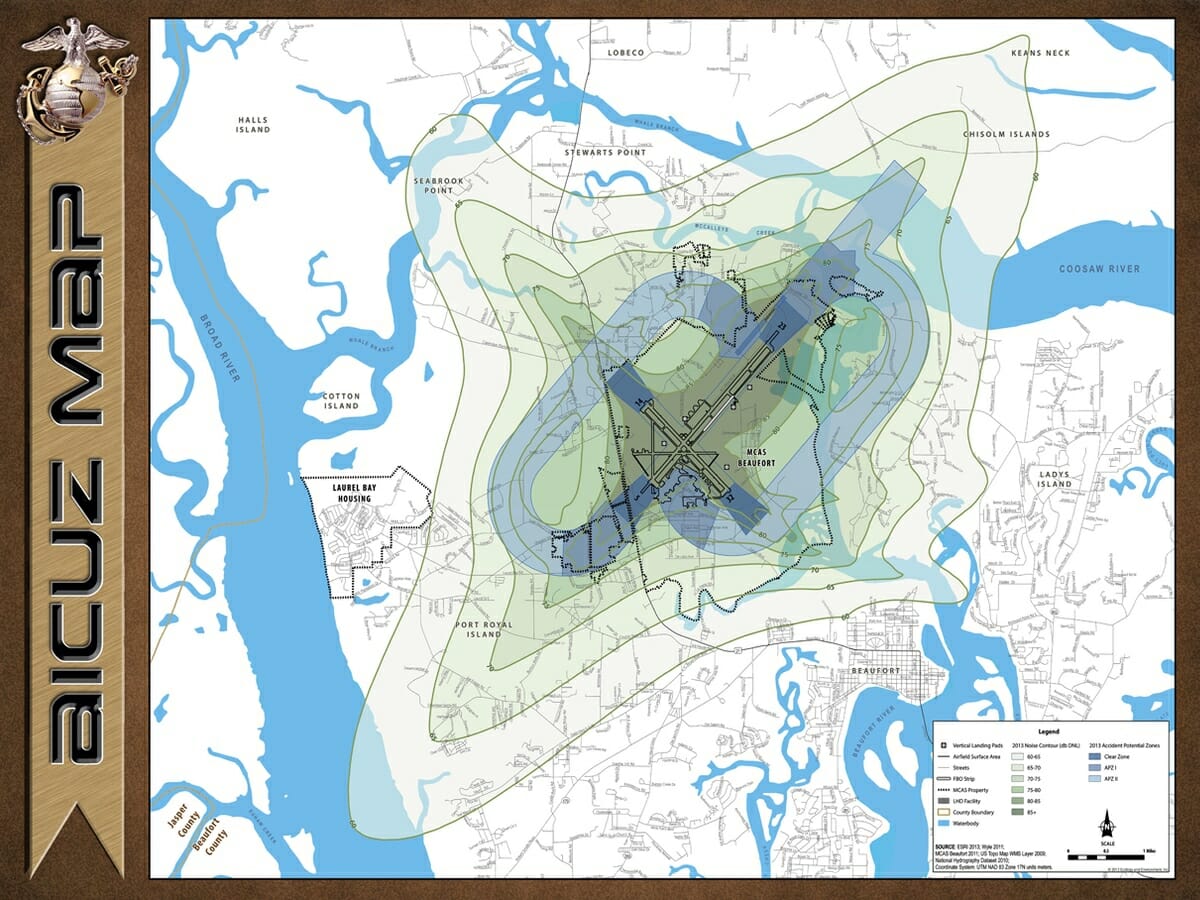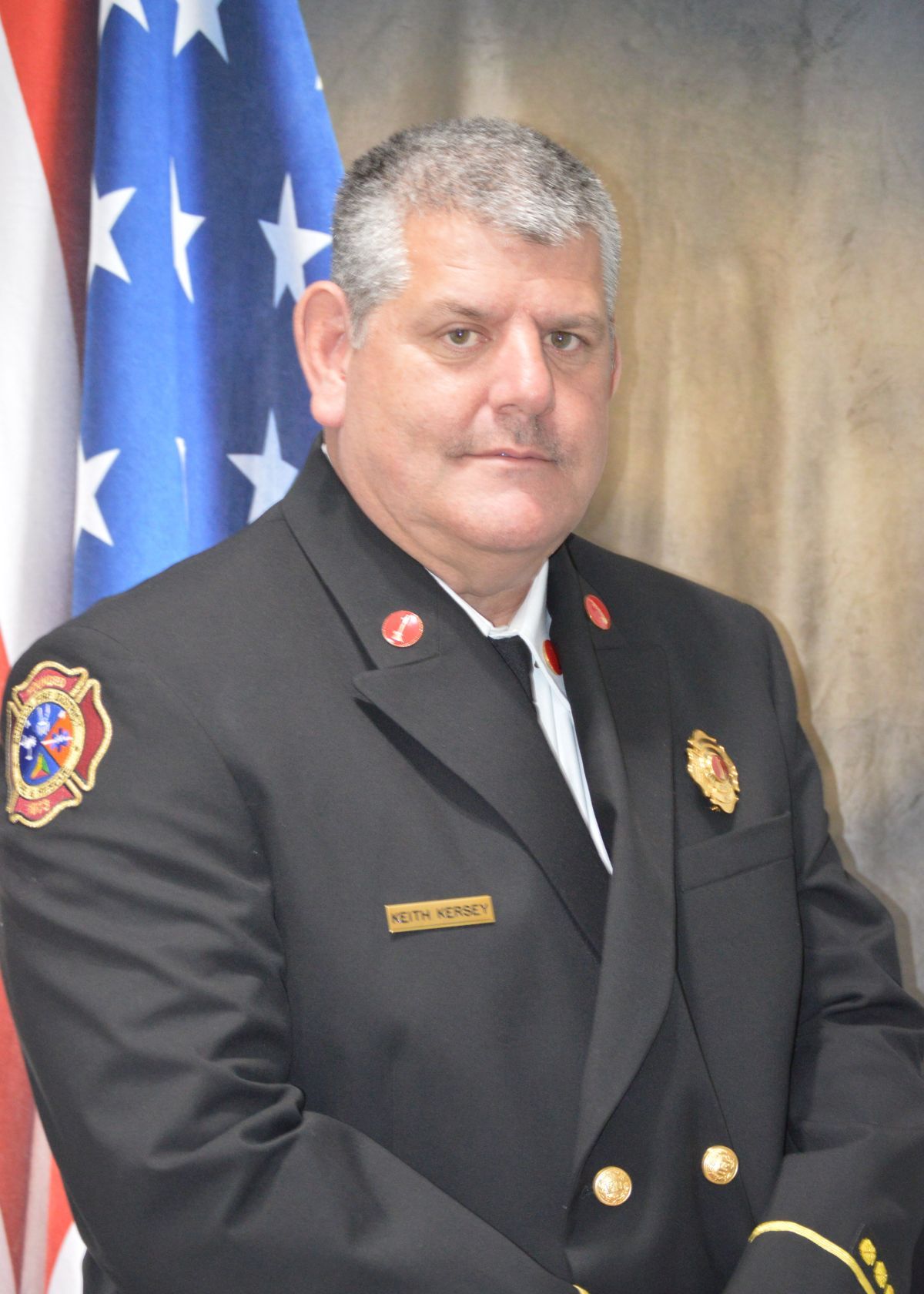Change in runways, noise from new F-35Bs and increased activity at MCAS impacting quality of life, residents say
By Mindy Lucas
Like a lot of visitors to Beaufort, Jayne Violette and her husband fell in love with the city from the very beginning.
The couple loved the rich history, the culture of the place and its small town charm. What’s more, as “pro-military” people, they even loved that there were military bases close by.
“We wanted to be in a town that celebrated patriotism,” she said.
So when looking for a new place to move to, naturally Beaufort came to mind.
In 2014, the couple found a small cottage off North Street, near the city’s historic district and after moving to the area permanently from Summerville, the two soon settled into their new lives in the Lowcountry.
They chose their home carefully, Violette said, after researching flight patterns from the fighter jets flying in and out of nearby Marine Corps Air Station Beaufort (MCAS).
“We chose it to be far away enough to appreciate the jets at a distance,” she said.
But all that changed toward the end of 2019, when MCAS closed its main runway for a repair project and diverted all air traffic to its “crosswind” runway.
“Our house would literally rattle,” she said. “The pictures on the walls would shake. We couldn’t sit outside.”
The repair project is just the latest issue, said Violette and other residents who have spoken up recently. A new fighter jet and increased flights over Beaufort are only adding to the problem, they say.
“We kept hearing this is only temporary, that it would go away. But it never did,” she said.
In March, the couple sold their house and moved to Bluffton where they now live on a quiet street in Sun City. But Violette is still a little heartbroken at having to leave her chosen city.
“We had this idyllic living arrangement,” she said. “We had that for a few years, and then it slowly went away.”
A Change in Runways
Situated to the east of U.S. Highway 21 and stretching some 12,200 feet in length, Runway 5/23 was purpose built with the prevailing winds in mind.
As the air station’s main runway, 5/23 sees about 75 to 80 percent of the air station’s plane traffic – when it’s open.
In November of 2019, MCAS closed the decades-old runway to begin a massive paving and repair project.
“When I say repair, it’s not like paving a parking lot,” said Kimberly Fleming, Director of Government and External Relations at MCAS.
As Fleming explained recently in a sit-down interview at the air station, the project includes “deep repairs” replacing two-feet of concrete from the top of the surface down and a new paved surface.
It is expected to be completed by the end of the year, she said.
When the main runway re-opens, those in neighborhoods currently being impacted by increases in noise or operations will see a return to how things were prior to the runway’s closure, Fleming said.
In the meantime, air traffic coming in and out of the base on “operations,” or the flying activity of an aircraft, has been using the air station’s shorter runway, or Runway 14/32.
That means residents in downtown Beaufort and surrounding neighborhoods have been seeing more air traffic from MCAS than they previously had, since most of the air station’s operations take place offshore or out over water.
And that has some folks at wits’ end.
“We are directly under the flight path,” said Laurence Mahorney, a retiree who lives in the Pigeon Point neighborhood, just north of Beaufort’s downtown historic district.
Mahorney, who bought his house in 2018, said he and his partner, Joanne Brown, use to enjoy working in the yard or sitting outside on their garden patio but that has changed.
“I watch these planes come ear shattering over, and they are not a little to the left or to the right. They are directly overhead,” he said.
Just as Violette did, Mahorney is considering a move to escape the noise, even though he and Brown have put a considerable amount of their savings into the new home.
“I appreciate the ‘Sound of Freedom,’ but if it comes to a point where it interrupts your phone calls, or you have to put your hands over your ears or it gives you a migraine, where do you draw the line?” he said.
Mahorney said he and Brown were looking to escape the congestion of the Charleston area when they discovered Beaufort, so quality of life was important to the couple.
In addition, Mahorney has Stage 4 Chronic Obstructive Pulmonary Disease so a quiet, relaxing environment was also key.
“I’m pretty resilient, but this is not comfortable, and we expected more than this when we bought our home,” he said.
Violette, a communications professor at the University of South Carolina Beaufort, can relate.
A Stage 3 breast cancer survivor, Violette too was looking for a “fresh start” in a peaceful setting when she and her husband started looking for a place to relocate.
“You start to think about your life and how you want to live,” she said. “We wanted to downsize and kind of recover. We thought it would be good for the soul.”
Violette’s husband also has a health condition that has made him sensitive to noise. The jets would fly over their house up until 11 p.m. some nights, she said, keeping him from falling asleep. It was hard watching her husband’s ability to cope deteriorate.
“It bothered me that it bothered him so much – seeing him suffer and not be able to do anything to help him,” she said.
And while Fleming and other air station officials have said the runway repair project will be completed within the year, both Violette and Mahorney remain skeptical that things will return to normal.
The noise caused by diverted air traffic is only one problem, they say. A new, very noticeable fighter jet and increased flights over the area have raised additional concerns.
A New Fighter Jet
Even before the MCAS began diverting air traffic to its crosswind runway, both Violette and Mahorney said they’d noticed the noise and volume of air traffic seemed to be getting worse.
Both cited the air stations’ newest jet as the culprit saying right away it seemed louder than the ones they were accustomed to seeing.
Designed to replace legacy aircraft such as the F/A-18 Hornets and the AV-8B Harriers, the F-35B Lightning II is a “highly advanced, stealth, supersonic, multi-role, strike-fighter aircraft” that can take off and land in a variety of settings, according to information from the MCAS.
It’s also loud, residents say.
“It’s to the point where it hurts your eardrums and gives you headaches,” Mahorney said.
While it’s hard to know exactly how loud the F-35s are since there are few studies on the jet’s noise levels, at least one study released by the Air Force and conducted specifically for the Burlington, Vermont area, suggested the F-35 is roughly four times louder than the F-16, according to news articles from May of 2019.
Back in Beaufort, the MCAS does admit they are slightly louder during conventional takeoffs and slightly quieter on conventional approaches but overall, they are comparable to the F-18s, Fleming said.
“A lot of times what people are trying to say when they say the noise is going to get louder is that the number of operations are going to increase,” she said. “And that’s because you have more consistent number of operations happening.”
That is especially true of the training center and fleet replacement squadrons, she said.
In addition to serving as an operational base for Marine Aircraft Group 31, which regularly rotates overseas wherever they are needed, the air station is also one of only two locations in the world where pilots train to fly the F-35Bs.
As Fleming explained, operational squadrons deploy, training squadrons do not.
“So they are here year round. And so I think that consistency is something that’s new,” she said. “It’s just more routine versus an ebb and a flow, so I think that is the difference when people talk about noise and the F-35B here and the F-18.”
Still, Mahorney and others aren’t convinced, and they aren’t alone.
From Boise, Idaho to South Burlington, Vermont, residents in communities living near airports or military bases have voiced their concerns after F-35s have come to town.
An environmental impact study released by the Air Force last summer regarding the possible stationing of an Air National Guard F-35 unit at the Boise Airport made headlines when the study showed the unit’s presence would regularly subject 272 households nearby to noise “as loud as a vacuum cleaner 3 feet away,” according to The Stars and Stripes and Idaho Statesmen.
The jets would have a “negligible impact” on the housing market nearby, Air Force officials stated, but residents and advocacy groups pushed back saying the houses would likely become unlivable if the F-35s were allowed to stay. Nearby schools would also be impacted making it difficult for those inside to hear what is being said, the study showed.
As one possible solution, residents have raised the idea of an auxiliary landing field that could handle certain low flying practice exercises, or what are known as “touch and go” flights.
The idea, which comes up from time to time, Fleming said, would be to take these particular types of exercises and put them on another air field – ideally farther out from communities.
In fact, former Congressman Mark Sanford went so far as to submit a request to facilitate a Needs Study by the Secretary of Defense for an auxiliary landing field, according to an Island News article from 2015.
However, when the MCAS looked at the number of operations and specific exercises the air station conducted that require the use of the main airfield, the numbers didn’t warrant such a field.
“The ‘touch and gos’ are a very small percentage of what we do and moving that somewhere else wouldn’t change the noise people would hear,” Fleming said. “It would be miniscule and people would not even be able to notice the difference.”
Operations Increasing
Adding to the problem, residents say, is the increase in flight activity at the base, which the MCAS confirms.
Ann Holderfield, who also lives in the Pigeon Point neighborhood, can’t remember exactly when she first began noticing the jets more, but said she’s seen a “significant  difference” in the noise and number of flights in just the last year or so.
difference” in the noise and number of flights in just the last year or so.
“I categorize them as loud, very loud, and hurts,” she said, adding the noise sometimes hurts her ears if she’s outside.
Holderfield, who bought her house in 2015, said the noise and vibrations which rattle her windows, have caused her increased anxiety and stress. It’s also impacted her quality of life, she said.
“I feel like I live right next to an airport,” she said. “It’s horrible. I can’t walk outside, and I don’t want to sit in my yard. I can’t think and I can’t relax.”
She would like to plan her walks or outdoor activities around the jets, but since flight paths and times can depend on a number of factors – weather conditions, local winds, presence of birds, training requirements and other factors – there is no set schedule for residents to go by.
But that doesn’t help Holderfield who feels trapped in her own home.
“I love my little house, and I love where I live in Beaufort,” she said. “But I do not love the sound of the jets flying over my house.”
Asked about the increased flights, which were released in an Air Installation Compatible Use Zones (AICUZ) study in 2013, the MCAS confirmed operations from F-35Bs into and out of MCAS Beaufort will nearly triple from 38,402 in 2012 to 106,030 by 2023.
The base is also approved to receive more F-35Bs in the next few years.
It currently has 29 of the fighter jets, though they are not always at home all at once, and is approved to receive a total of 88 which it expects to receive sometime by the mid 2020s.
Asked what MCAS officials would say to residents of Pigeon Point or other areas impacted by the increased noise and flights, Fleming said for every complaint she gets, she also gets those who say they are glad they are here.
“This community is unique among probably any in the country in that it is such a welcoming community that wants us to be here, that supports what we do and understands the importance of what we do,” she said.
She went on to say that she personally thinks about those young Marines who are deployed or who are “pinned down in a firefight.”
“They’re relying on that pilot to know what he’s doing, and that he has been properly trained to come save him,” she said. “I think we owe it to every Marine that’s deploying to bring them home safely to their families and this is part of what we do to make that happen.”
Defenders of the “Sound of Freedom” also point to the air station’s economic impact on the area.
As the biggest economic driver in Northern Beaufort County, the Tri-Command, which includes Marine Corps Recruit Depot Parris Island and the Naval Hospital Beaufort along with the air station, provides $2 billion in economic impact each year, according to a 2017 study by the South Carolina Military Base Task Force.
MCAS Beaufort alone generates $787 million in economic activity each year and sustains over 7,250 jobs in the local area, the study found.
Still, it is exactly for these reasons that residents said any complaints or concerns they may have are made to feel invalid. Some have even been met with unwanted hostility.
Speaking out
Even though Mahorney and Holderfield have privately heard from neighbors and others affected by the noise, both said when they have broached the subject on their neighborhood Facebook page, they were told if they didn’t like it they could move.
Some accused them of being unpatriotic or anti-American.
“I love America, I love our heroes, I love being a patriot,” said Mahorney. “But like I argued with (one) guy on the page, at what point does it become an issue? When your kids can’t sleep, or it becomes a health issue? At what point do you say that’s enough and not get accused of being a communist?”
Holderfield said she too was attacked on the page for just asking if anyone else had noticed the increased noise and flights. Her significant other is a veteran and he’s not thrilled with it either, she said.
People have also asked why Holderfield’s real estate agent didn’t disclose the area’s noise to her when she bought the home, she said. But the property is not in the noise contour requiring a signed disclosure. In fact, her home, less than a mile from Pigeon Point Boat Landing, is right on the cusp.
What’s more, the 2013 update to the AICUZ study, designed for land use compatibility guidelines, was conducted in anticipation of the F35B arrivals, not for any paving projects that might divert air traffic over Beaufort.
“These aren’t meant for short-term changes,” said Fleming. “These are meant for long-term changes.”
Fleming, who often speaks to neighborhood groups or community meetings, said part of her role is make sure the community is informed.
In fact, Fleming is slated to speak at the July 20 Metropolitan Planning Commission Meeting where the question of where the air station is with the pavement project recently came up.
With greater numbers of people retiring and flocking to the Lowcountry, educating newcomers to the area will always be a challenge and ongoing for the air station, she said.
The AICUZ study and noise contour map is available online for anyone who may be interested in buying a house or building a home in a specific area.
“We try and do our best to be forthcoming and transparent with our information. We want people to be informed and if they aren’t informed, we get some of these questions and clearly we need to do better,” she said.
Violette, who no longer lives in Beaufort, said she would have liked the city to have taken a more active role in working with the air station on getting the word out about the changes.
“I don’t feel that city leaders did enough to generate conversations about the noise that was going to occur,” she said. “I felt there were others who felt the same way as we did, but they were afraid to come forward because you get slapped down if you speak out.”
For Violette and her husband, those conversations have come too late.
“Anyone who knows me, knows how delighted I was to be living in Beaufort,” she said. “To be part of the community, and to enjoy everything that Beaufort has to offer …we just couldn’t stay. If it weren’t for the jet noise we would still be living in Beaufort.”
Above: The air station encourages those looking to buy or build a home in the area to use the Air Installations Compatible Use Zones (AICUZ) Planning Map as a guide. Many residents have found they are on the edge of the 60-65 Day-Night Average Sound Level (DNL). The MCAS pavement project has also impacted those noise levels, not part of this study. Courtesy: Marine Corps Air Station Beaufort.
Beaufort resident Ann Holderfield regularly sees and hears F-35 fighter jets like this one, from a video she filmed, over her house in Pigeon Point.








